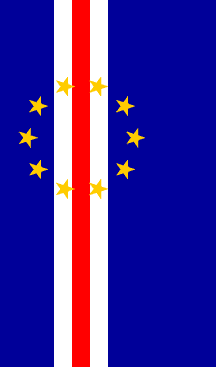 image by Željko Heimer, 30 March 2016
image by Željko Heimer, 30 March 2016
Last modified: 2023-08-19 by rob raeside
Keywords: cabo verde | cape verde |
Links: FOTW homepage |
search |
disclaimer and copyright |
write us |
mirrors
 image by Željko Heimer, 30 March 2016
image by Željko Heimer, 30 March 2016
See also:
External links:
Editorial remark: In 2013, the Government of this country requested that its common name in other languages should be unmodified "Cabo Verde". To conform with this request, the half-anglicized form "Cape Verde" was duly replaced in our pages for all editorial text, such as titles and listings. Previously received contributions were kept unchanged.
A new flag was adopted on 22 Sep 1992, when Cape Verde finally severed its links with Guinea-Bissau. The new flag has 10 stars representing the islands, set in a blue sea. Prior to 1992, the similarity between the two nations’ flags was explained by the fact that both were derived from the flag of the Partido Africano da Independência da Guiné e Cabo Verde (P.A.I.G.C.), the liberation movement which succeeded in gaining independence for both countries (Guinea-Bissau in 1974, Cape Verde in 1975). P.A.I.G.C.’s aim had been that the two nations should unite, but this merger was scotched in 1980 by a military coup in Guinea-Bissau.C. Veale, quoting [dev94]
In a letter, dated 19 January 1993 of the office of the Ministry of Culture and Communications, I was told as follows:
The ten yellow stars represent the ten islands. They are in a circle meaning by this way the unity of the whole country and of the people.In the only interview I have ever seen with the designer of the flag of Cabo Verde, Pedro Gregório Lopes, mentions that the ten stars represent the ten islands.
The website of CV embassy in US describes the location of Cape Verde as:
West African archipelago of 10 islands and 8 islets, divided into two groups: Northern Windward (Barlavento): Boa Vista, Sal, Santo Antão, São Vicente, São Nicolau, and Santa Luzia; Southern Leeward (Sotavento): Brava, Fogo, Maio, Santiago.A quick comparison to a list of inhabited islands tells you Santa Luzia is uninhabited but is counted as an island. Indeed, this is clearly an island; significantly larger than the islets at about half the size of the next larger island, Brava. In fact, Santa Luzia used to be an inhabited island in the past but lost its population in 1960 when living conditions became unfavourable.
There is a relationship between the flags of the
Azores and Cape Verde: Both are Atlantic
archipelagos, both have a Portuguese history and both flags include a
lineup of golden stars representing the islands.
Volker Monterey, 27 Jan 2014
Recognizably in locally used languages, the word "verde" /
"berdi" (as used in the country’s name) does mean "green"
— a color deemed unsuitable for a country where drought is endemic
(«Txuba!»), and where the (blue) sea feeds the people:
That was one of the reasons behind the lack of any green (a would-be
canting element) on the new
national flag of 1992, as explained by the flag’s designer
Gregório Lopes in
this
interview.
António Martins, 30 Mar 2016
 image by Željko Heimer, 30 Mar 2016
image by Željko Heimer, 30 Mar 2016
The protocol manual for the London 2012 Olympics
[loc12], with info approved by each
NOC, gives for Cape Verde a vertical flag that
is simply the horizontal version turned 90 degrees
clockwise.
Ian Sumner, 10 Oct 2012
.gif) image by Waldir and TonyJeff, extracted from
Wikimedia
Commons, 05 May 2016
image by Waldir and TonyJeff, extracted from
Wikimedia
Commons, 05 May 2016
As on the flag, the stars
represent the main islands of Cape Verde; the plumb-bob is symbolic of
rectitude and virtue; the torch and triangle represent unity and
freedom.
Ivan Sache, 21 Jan 2001
It is interesting to note that this exact emblem doesn’t show on
any flag we know so far (maybe on the elusive presidential flag — if
it exists at all?), but yet some of its elements inspired many emblems
(which are used on flags): The disc shaped shield, the arch of ten stars
in two halves, and the chain links.
António Martins, 05 May 2016
Seems that the gathering of these 10 stars in
two equal subsets of 5 is merely an esthetic / geometric choice;
they don’t stand for the the two groups of
islands that make up the country as those comprehend respectively 6
and 4 islands.
António Martins, 30 Mar 2016
The chain links are also found in most municipal
emblems, but colored green.
António Martins, 30 Mar 2016
Força Aérea Caboverdiana (formed 1982 — 6 cargo
and light planes) and Guarda Costeira de Cabo Verde (with 1 plane);
the book [cos98] reports a
national flag as fin flash (changed as the
flag changed in 1992). See on line photos with
old
and
new
markings, and the coast guard’s only plane with the
flag-fin flash.
Dov Gutterman, 13 Jun 2004
At the official web site, the emblem
of the Civil Defense of Cape Verde, almost identical to the
Portuguese one, including the basic design of
a blue triangle on orange, as prescribed by the
Geneva Convention. I could not find any
mention to a flag, though, nor shown nor described.
António Martins, 14 Jan 2007 and 26 Mar 2016